India has recently joined the Minerals Security Finance Network (MSFN), which stems from the Minerals Security Partnership (MSP). The announcement was made by the US State Department on the margins of the United Nations General Assembly on September 23.
In June 2023, India was inducted into the MSP, a US-led collaboration of these 14 countries that aimed to catalyse public and private investment in critical mineral supply chains globally.
MSP partners include Australia, Canada, Estonia, Finland, France, Germany,India, Italy, Japan, Norway, the Republic of Korea, Sweden, the United Kingdom, the United States, and the European Union (represented by the European Commission).
The MSP grouping is focused on the supply chains of minerals such as Cobalt, Nickel, Lithium, and also the 17 ‘rare earth’ minerals. The alliance is seen as primarily focused on evolving an alternative to China, which has created processing infrastructure in rare earth minerals and has acquired mines in Africa for elements such as Cobalt.
The collaboration is currently engaged in fostering a critical minerals and metals cooperation forum for the sharing of expertise, building a robust battery materials supply chain, and jointly developing a minerals processing facility in South America.
The strengthening of the MSP with an additional offshoot in the MSFN in September comes at a time when there is an overwhelming dependence on countries such as China for critical resources, especially with respect to rare earth minerals.
Under this new partnership, signatory nations acknowledged that the scope and scale of meeting the rapidly increasing global demand for critical minerals to achieve the proposed clean energy transition was “beyond the purview of any single institution” and that the public sector and private sector in member countries “would need to work together to deploy capital into new and existing markets in this sector”.
Critical Minerals
A mineral is characterised as critical when the risk of supply shortage and associated impact on the economy is (relatively) higher than other raw materials. This definition of a critical mineral was first adopted in the US.
The European Union also carried out a similar exercise and categorised critical minerals on the basis of two prerequisites: supply risk and economic importance. But, there is no universally accepted defination of critical minerals.
Rare Earths
The 17 rare earth elements (REE) include the 15 Lanthanides (atomic numbers 57 — which is Lanthanum — to 71 in the periodic table) plus Scandium (atomic number 21) and Yttrium (39).
REEs are classified as light RE elements (LREE) and heavy RE elements (HREE).
REEs are an essential — although often tiny — component of more than 200 consumer products, including mobile phones, computer hard drives, electric and hybrid vehicles, semiconductors, flatscreen TVs and monitors, and high-end electronics. India is seen as a late mover in attempts to enter the lithium value chain, coming at a time when EVs are predicted to be a sector ripe for disruption.
Some REEs are available in India — such as Lanthanum, Cerium, Neodymium, Praseodymium and Samarium, etc. Others such as Dysprosium, Terbium, and Europium, which are classified as HREEs, are not available in Indian deposits in extractable quantities.
Hence, there is a dependence on countries such as China for HREEs, which is one of the leading producers of REEs, with an estimated 70 per cent share of the global production.

Uses of Rare Earth Elements
Rare earth metals and alloys that contain them are used in many devices that people use every day such as computer memory, DVDs, rechargeable batteries, cell phones, catalytic converters, magnets, fluorescent lighting and much more.
Rare earths are used as catalysts, phosphors, and polishing compounds. These are used for air pollution control, illuminated screens on electronic devices, and the polishing of optical-quality glass. All of these products are expected to experience rising demand.
Rare earth elements play an essential role in our national defense. The military uses night-vision goggles, precision-guided weapons, communications equipment, GPS equipment, batteries, and other defense electronics.

